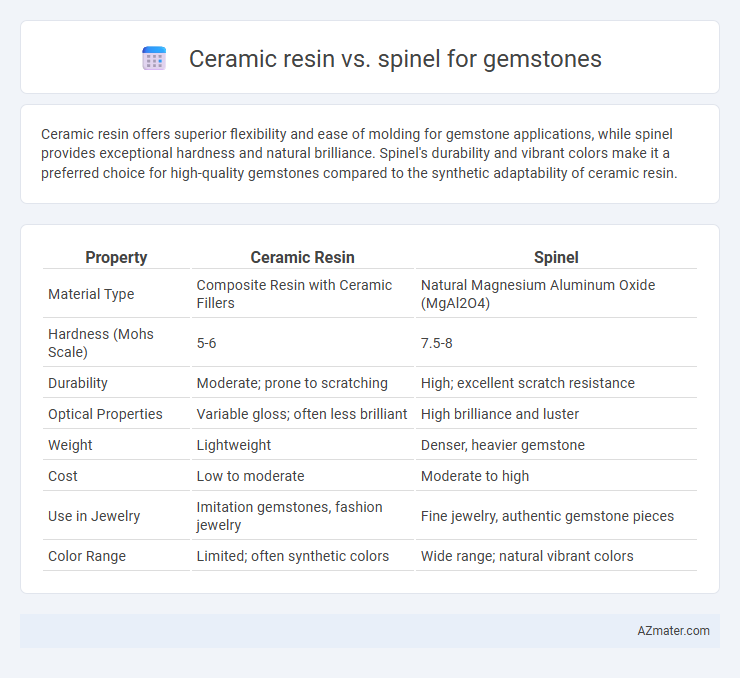Ceramic resin offers superior flexibility and ease of molding for gemstone applications, while spinel provides exceptional hardness and natural brilliance. Spinel's durability and vibrant colors make it a preferred choice for high-quality gemstones compared to the synthetic adaptability of ceramic resin.
Table of Comparison
| Property | Ceramic Resin | Spinel |
|---|---|---|
| Material Type | Composite Resin with Ceramic Fillers | Natural Magnesium Aluminum Oxide (MgAl2O4) |
| Hardness (Mohs Scale) | 5-6 | 7.5-8 |
| Durability | Moderate; prone to scratching | High; excellent scratch resistance |
| Optical Properties | Variable gloss; often less brilliant | High brilliance and luster |
| Weight | Lightweight | Denser, heavier gemstone |
| Cost | Low to moderate | Moderate to high |
| Use in Jewelry | Imitation gemstones, fashion jewelry | Fine jewelry, authentic gemstone pieces |
| Color Range | Limited; often synthetic colors | Wide range; natural vibrant colors |
Introduction to Ceramic Resin and Spinel Gemstones
Ceramic resin gemstones are engineered composites known for their durability and vibrant color range, making them popular in affordable jewelry. Spinel is a naturally occurring gemstone prized for its hardness, brilliance, and wide variety of colors, often mistaken for ruby or sapphire due to its similar appearance. The main distinction lies in ceramic resin being synthetic with customizable properties, whereas spinel is valued for its natural origin and lasting physical characteristics.
Composition and Formation of Ceramic Resin vs Spinel
Ceramic resin is a composite material formed by embedding ceramic particles within a synthetic polymer matrix, typically created through curing processes involving epoxies or polyesters. Spinel is a naturally occurring crystalline mineral composed primarily of magnesium aluminate (MgAl2O4), formed through high-temperature metamorphic or magmatic processes in the Earth's mantle. The synthetic formation of ceramic resin contrasts with the geological crystallization of spinel, resulting in distinct physical and chemical properties relevant to gemstone applications.
Physical Properties: Hardness, Durability, and Luster
Ceramic resin gemstones exhibit moderate hardness around 6 to 7 on the Mohs scale, offering good durability but less scratch resistance compared to spinel, which ranks 7.5 to 8, providing superior hardness and long-lasting resilience. Spinel's natural crystal structure delivers exceptional luster with a vivid glassy shine, whereas ceramic resin often relies on surface treatments to mimic this brilliance. Durability in spinel is enhanced by its fracture toughness, making it ideal for everyday wear, while ceramic resin gemstones require careful handling due to their comparatively lower toughness and susceptibility to surface abrasion.
Visual Differences: Color Range and Clarity
Ceramic resin gemstones typically exhibit a narrower color range with muted tones and less brilliance compared to spinel, which offers vibrant hues and exceptional clarity. Spinel is prized for its vivid, saturated colors ranging from intense reds to blues and purples, along with high transparency and minimal inclusions. In contrast, ceramic resin often appears more opaque with a plastic-like luster, lacking the natural sparkle and depth found in genuine spinel stones.
Popular Uses in Jewelry and Design
Ceramic resin and spinel are popular choices for gemstone applications in jewelry and design due to their unique properties. Ceramic resin offers versatility and lightweight durability, making it ideal for fashion-forward, customizable pieces such as rings and bracelets with intricate designs. Spinel, prized for its natural brilliance and range of vibrant colors, is commonly used in fine jewelry, including engagement rings and pendant necklaces, valued for its hardness and gemstone quality.
Price Comparison and Market Value
Ceramic resin gemstones typically offer a lower price point compared to Spinel, making them a cost-effective choice for decorative uses. Spinel gemstones, valued for their natural rarity and vibrant colors, command higher market prices and stronger resale value. Investment in Spinel is often favored due to its enduring demand and recognition within the fine gemstone market.
Synthetic vs Natural: Sourcing and Ethics
Synthetic ceramic resin gemstones offer consistent quality and ethical sourcing by avoiding mining practices associated with environmental degradation and labor concerns common in natural spinel extraction. Natural spinel, prized for its rarity and unique inclusions, often faces challenges related to ethical sourcing due to geopolitical issues and unsustainable mining methods. Choosing synthetic alternatives like ceramic resin supports sustainable production while delivering gemstone options that closely mimic the appearance and durability of natural spinel.
Maintenance and Care Tips
Ceramic resin gemstones require regular cleaning with mild soap and water to maintain their glossy finish, avoiding harsh chemicals that can cause surface damage. Spinel gemstones are more durable and resist scratches better but should be cleaned gently with a soft brush and warm soapy water to preserve their natural luster. Both materials benefit from storage in soft pouches or separate compartments to prevent abrasion and maintain long-term clarity and brilliance.
Pros and Cons: Ceramic Resin vs Spinel
Ceramic resin offers lightweight durability and lower cost, making it an accessible option for gemstone jewelry, but it lacks the scratch resistance and natural brilliance of spinel. Spinel excels with its vibrant color palette, exceptional hardness (8 on the Mohs scale), and natural origin, enhancing both value and longevity. However, spinel's higher price and occasional rarity in larger sizes can be limiting factors compared to more affordable and versatile ceramic resin alternatives.
Choosing the Right Gemstone for Your Needs
Ceramic resin gemstones offer affordability and vibrant colors, making them ideal for fashion jewelry and casual wear, while spinel gemstones provide superior hardness and natural brilliance suited for fine jewelry and daily wear. Spinel ranks 7.5-8 on the Mohs scale, ensuring durability, whereas ceramic resin lacks natural hardness but allows for customizable shapes and affordability. Selecting the right gemstone depends on balancing budget, durability needs, and desired aesthetic qualities for long-term satisfaction.

Infographic: Ceramic resin vs Spinel for Gemstone
 azmater.com
azmater.com